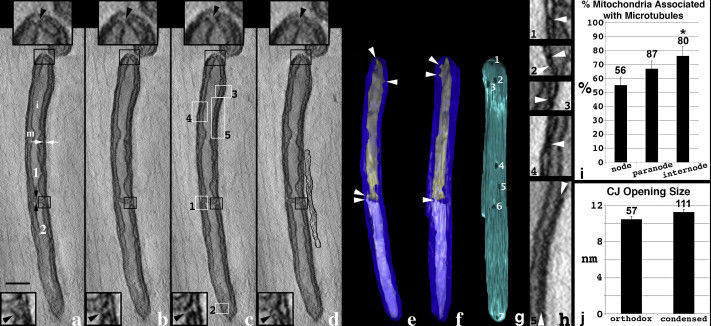Research Highlights
Mitochondrial configurations in peripheral nerve suggest differential ATP production.
December 2010
NCMIR researchers used electron tomography to examine mitochondria, the cell’s principal energy producers, in the peripheral nervous system (PNS) in a study that points to differential energy usage along neurons. The morphological diversity of mitochondria in neurons appears to be the rule rather than the exception as these cells are highly polar, being composed of dendrites, somas, synapses, and axons -- compartments with differing functions, molecules, and energetic needs. The abundance and conformational states of mitochondria in peripheral nerve were investigated because of energy considerations for action potential propagation in axons and especially the high metabolic load required to support ionic fluxes and phosphorylation and dephosphorylation of the molecular machinery (for opening and closing channels or binding to or unbinding from receptors or enzymes) concentrated at the node of Ranvier (a defined structure that governs how an action potential signal jumps along the axon, from node to node). Neuronal mitochondria display considerable structural diversity, particularly with respect to their cristae, the internal and unique membrane system governing ATP production, the primary molecule used as the energy currency of the cell. Evidence is accumulating that the topology of the cristae membranes is not random but rather is a regulated parameter. Cristae topology affects the diffusion of metabolites and soluble proteins that can influence mitochondrial ATP generation. The condensed state of cristae corresponds to ATP generation several times higher than normal. An abundance of condensed mitochondria in PNS axons was reported with the density of mitochondria greatest at the node of Ranvier, supporting the concept that there is a need for the mitochondria to operate at a high workload of ATP production, especially at the node. This type of mitochondrial state does not occur in the surrounding Schwann cells that generate the myelin wrappings around the axon or in central nervous system (CNS) axons, suggesting that the extreme length of PNS axons requires that mitochondria are transported and positioned such that proper functioning matches with maintaining high areas of ATP production in the most energy intensive axonal areas, i.e., the node of Ranvier. The positioning and energetic state of mitochondria appears to be essential for neuronal energy homeostasis.
Full text: http://www.ncbi.nlm.nih.gov/pubmed/20600951
Related Publications
Perkins GA, Ellisman MH. Mitochondrial configurations in peripheral nerve suggest differential ATP production. J Struct Biol. 2011 Jan;173(1):117-27. Epub 2010 Jun 25.

